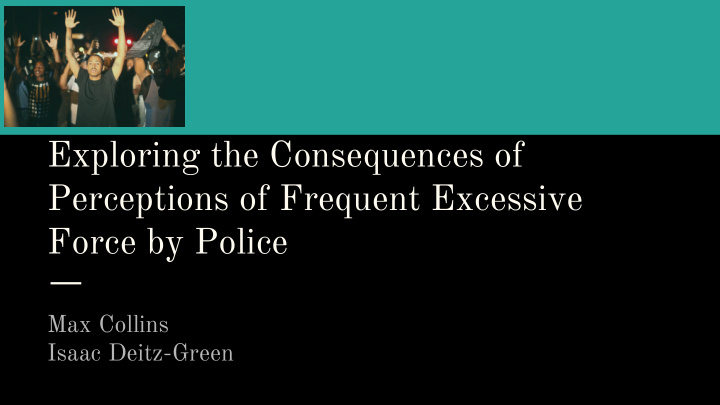



Exploring the Consequences of Perceptions of Frequent Excessive Force by Police Max Collins Isaac Deitz-Green
Excuse me officer... •We’ve seen that police behaviors differ towards Whites and non-Whites (Stop-and-Frisk Data, NYCLU 2015). • Non-Whites are victims of excessive force by police at proportionally much higher rates than Whites in America. Black Americans were more than two times as likely as whites to report being threatened with force or to have experienced it in their most recent police encounter (Reilly, 2015).
Why are people identifying less with police? (lit review) Operationalize increased tensions with less identification
Consequences of Perceptions of Police Force ● Excessive force represents ‘threat.’ ● When threat is seen as directed at a salient aspect of group identity, it can alienate ingroup members from members of the threatening outgroup (citation). ● We measured identification with police, predicting that if non-Whites perceived excessive force as a threat to their non-White group identities, they would identify less with police.
• “Fifth estate” allows for news coverage to spread quickly by the masses. This leads to shifting public perception of law enforcement. • The spreading of info about excessive police force has resonated with many people, as shown by new social movements like Black Lives Matter. • These movements push toward more equal treatment by officers and holding officers accountable (Edwards, Harris 2016).
Laquan McDonald
Methods ● Sample: 187 participants ● ~40% Male, ~60% Female ● 92 white, 95 non-white ● Mean age = 28.04 ● Participants approached in NYC public parks with paper surveys ● Compensated with granola bars
Methods ● Variables of interest: “identification with police” and “perception of the frequency of excessive force by police.” ● Identification with police tested with seven 1-7 likert-scale questions. ○ “If you talked to most police officers, you think you would find that they have similar views to your own on many issues,” ○ “If most police officers knew you, they would respect your values.” ● Perception of the frequency of excessive force by police tested with two 1-7 likert-scale questions and one multiple choice. ○ “How frequent/common do you think incidents of police excessive force are?” ○ “What percentage of police officers in the US do you think have engaged in excessive force at some point in their career?” ■ Options from 0-50%, in increments of 3
Results Interaction: β = .18, t(182) = 1.71, p=.089 Slope of White line: β = -.18, t(182) = -2.56, p=.01 Slope of Nonwhite line: β = -.47, t(182) = -4.29, p<.001 Difference of points at high excessive force: β = .30, t(182) = 3.09, p=.002
Discussion ● Main Findings: Thinking police frequently use excessive force is associated with less identification with police. ● Identification is especially lower among non-whites compared to whites.
Follow Up Studies ● Study to establish causality -- Fake Newspaper Manipulation ○ Testing for causality with a manipulation using newspaper articles that we create. ○ One article says a high number of police use excessive force. ○ One article says not many police use excessive force. ○ Do we find the same pattern (no difference between whites/nonwhites in low excessive force condition, larger difference in high excessive force condition).
Implications ● Why does this difference in identification matter? ○ Less identification could lead to higher tensions. ○ Feelings of hopelessness around resolving the issue. ● Interventions ○ Train officers differently, less excessive force (which is not subjective) could lead to greater identification between the public and the police. ○ Create more of a common ground between officers and the public.
References Edwards, S. B., & Harris, D. (2016). Black lives matter . Essential Library, an imprint of ABDO Publishing. ❖ ❖ Reilly, R. J. (2015, November 16). Black Americans Twice As Likely To Report Force In Last Police Encounter. Retrieved July 14, 2016, from http://www.huffingtonpost.com/entry/use-of-force-statistics-doj_us_564a1d4ae4b06037734a24ae Stop-and-Frisk Data | New York Civil Liberties Union (NYCLU) - American Civil Liberties Union of New York State. ❖ (n.d.). Retrieved July 13, 2016, from http://www.nyclu.org/content/stop-and-frisk-data “We’re not seeing more police shootings, just more news coverage.” McLaughlin, Eliot; CNN. April 21st, 2015 ❖ Images http://www.frontpagemag.com/sites/default/files/uploads/2014/06/serrano130527_2_560.jpg ❖ ❖ http://cdn3.vox-cdn.com/assets/4894406/453548876.jpg http://a57.foxnews.com/images.foxnews.com/content/fox-news/us/2014/11/27/hands-up-dont-shoot-becomes-rallying ❖ -cry-despite-questions-whether-hands-were/_jcr_content/par/featured-media/media-1.img.jpg/876/493/14488737703 74.jpg?ve=1&tl=1 ❖
Recommend
More recommend